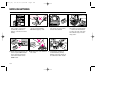
161
Single Servo AF
Once the subject is in focus, focus is locked. Useful for recom-
posing the picture.
Slow Sync
A flash technique for using the flash at a slow shutter speed.
Flash shooting in dim light or at night at a fast shutter speed
often results in a flash-illuminated subject against a dark back-
ground. Using a slower shutter speed with the flash brings out
the background details in the picture. Use of a slow shutter
speed with Rear-Curtain Sync is particularly effective for illustrat-
ing the movement of a stream of light.
The F5’s Slow Sync mode extends the automatically controlled
shutter speed range (in Programmed Auto and Aperture-Priority
Auto) down to 30 sec.
SLR
Single Lens Reflex. A type of camera that allows you to see
through the camera’s lens as you look in the camera’s
viewfinder. Other camera functions, such as light metering and
flash control, also operate through the camera’s lens.
Standard TTL flash
A type of TTL auto flash that does not apply any automatic flash
output level compensation. Flash output is controlled indepen-
dently from the ambient light exposure measurement and, in
most cases, illuminates a subject somewhat more strongly than
with Automatic Balanced Fill-Flash, making the subject stand
out distinctly from the background.
TTL
Through-the-Lens. Most SLR cameras have built-in meters
which measure light after it has passed through the lens, a
feature that enables exposure readings to be taken from the
actual image about to be recorded on film, whatever the lens
angle of view and regardless of whether a filter is used or not.
TTL auto flash
The camera’s light sensor measures flash illumination, as
reflected by the subject on the film and shuts off the flash when
measurement indicates a correct exposure. Because the sensor
that controls the flash receives light through the lens, TTL auto
flash can be used for bounce flash photography, fill-flash, multi-
ple flash photography, etc. An additional advantage of TTL auto
flash is that it enables you to use a wide range of aperture
settings, while ensuring correct exposure.
Vignetting
Progressively diminished illumination on the film from the center
to the corners. There are two kinds of vignetting—natural
vignetting caused by the lens, and vignetting that is caused by
improper use of accessories such as a lens hood or filter.
P400 (E) 02.12.27 6:42 PM Page 161


















